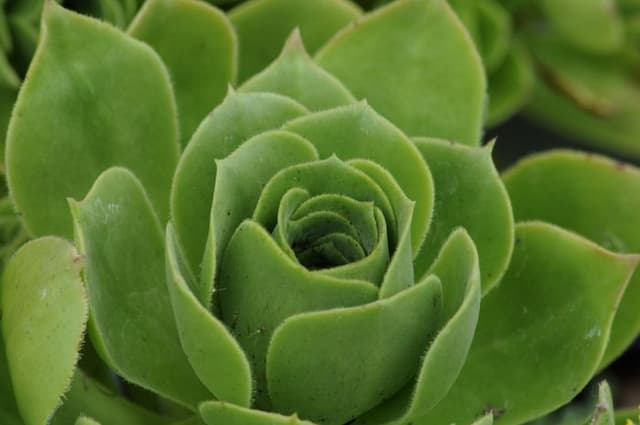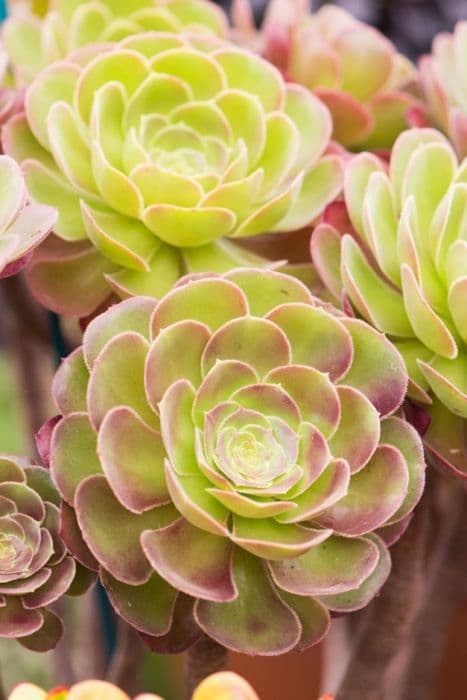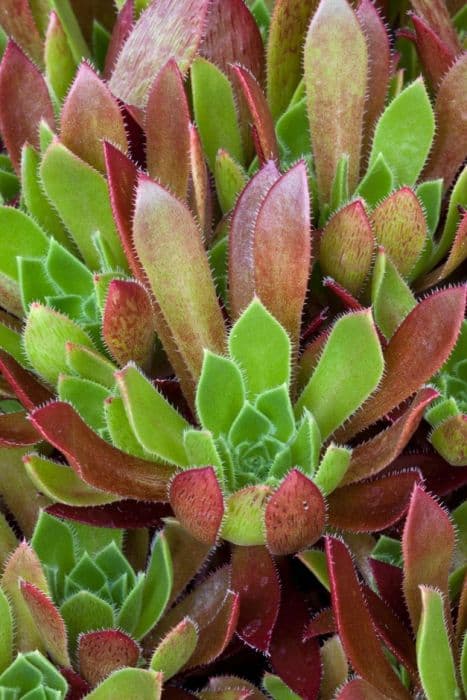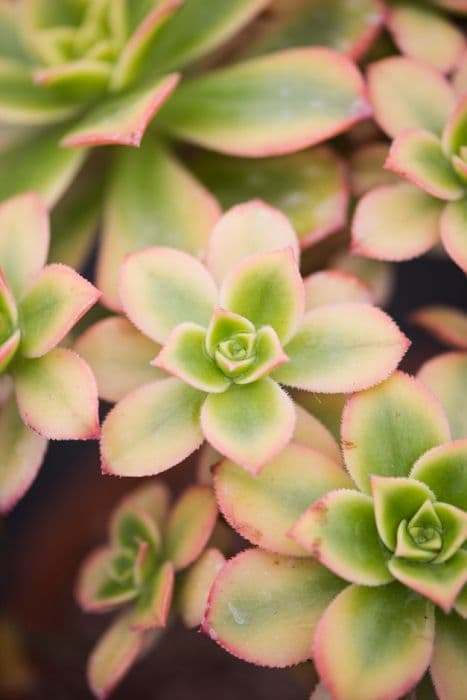Stonecrop 'Coral Carpet' Sedum album 'Coral Carpet'










ABOUT
'Coral Carpet is an evergreen, mat-forming perennial with small, succulent, rounded green leaves flushed with red. Star-shaped white flowers are borne in clusters above the foliage in early summer
About this plant
 Names
NamesFamily
Crassulaceae
Synonyms
White Stonecrop, Coral Carpet, Small Houseleek, Sea Pink
Common names
Sedum album 'Coral Carpet'.
 Characteristics
CharacteristicsLife cycle
Perennials
Foliage type
Evergreen
Color of leaves
Green
Flower color
White
Height
0.17 feet (5 cm)
Spread
1 foot (30 cm)
Plant type
Succulent
Hardiness zones
5
Native area
Europe
Benefits
 General Benefits
General Benefits- Low Maintenance: Sedum album 'Coral Carpet' requires minimal care, making it ideal for gardeners of all skill levels.
- Drought Tolerant: This plant has a high tolerance for drought conditions once established, reducing the need for frequent watering.
- Ground Cover: It is an excellent ground cover that can help prevent soil erosion and suppress weeds.
- Attracts Pollinators: The flowers attract bees and other pollinators, benefiting the biodiversity of the garden.
- Aesthetic Appeal: With its succulent leaves turning from green to coral red, it provides seasonal interest and aesthetic appeal.
- Cold Hardy: It is capable of withstanding colder temperatures, making it suitable for a variety of climates.
- Rock Gardens: Perfect for rock gardens, its ability to thrive in rocky, well-drained soils adds versatility to garden design.
- Roof Gardens: Its shallow root system and tolerance to extreme conditions make it ideal for planting on green roofs.
- Containers and Edging: It can be used in containers and as edging for paths or borders, offering structural variety in garden arrangements.
 Medical Properties
Medical Properties- Anti-inflammatory: Some species of Sedum are known to contain compounds that may help reduce inflammation, potentially relevant to Sedum album 'Coral Carpet'.
- Antiseptic: The juice from the leaves may have antiseptic properties, useful for cleaning minor wounds or cuts.
- Astringent: Extracts from Sedum album might act as an astringent, potentially helping to tighten skin or tissue.
- Diuretic: Certain Sedum species may promote urine production, which is sometimes desirable in treating certain conditions.
 Air-purifying Qualities
Air-purifying QualitiesThis plant is not specifically known for air purifying qualities.
 Other Uses
Other Uses- Roof Greening: White stonecrop is often used as a hardy, drought-tolerant plant in green roofing systems, helping to regulate building temperature and manage rainwater runoff.
- Ground Cover for Xeriscaping: This plant is suitable for xeriscaping—gardening that reduces or eliminates the need for supplemental water from irrigation.
- Soil Erosion Control: White stonecrop can help prevent soil erosion due to its spreading habit and root system that holds soil in place.
- Garden Path Edging: The compact and low-growing nature of this sedum makes it ideal for defining the edges of pathways and borders in gardens.
- Rock Gardens: Its ability to thrive in rocky, poor soil makes white stonecrop an excellent choice for rock gardens, emulating the look of alpine landscapes.
- Butterfly Gardens: White stonecrop flowers are attractive to butterflies, making it a beneficial addition to butterfly gardens.
- Fairy Gardens: Due to its small scale and tolerance for shallow soil, it's often used in fairy gardens for a whimsical effect.
- Livestock Feed: In some regions, sedum species are grazed by livestock as part of their forage.
- Living Mulch: White stonecrop can be used as a living mulch to suppress weeds and maintain soil moisture due to its dense growth.
- Architectural Accents: With its textured foliage and spreading form, white stonecrop can be used to add visual interest to contemporary architectural designs.
Interesting Facts
 Feng Shui
Feng ShuiWhite stonecrop is not used in Feng Shui practice.
 Zodiac Sign Compitability
Zodiac Sign CompitabilityWhite stonecrop is not used in astrology practice.
 Plant Symbolism
Plant Symbolism- Resilience: Sedum album, commonly known as white stonecrop, is known for its hardiness and ability to thrive in poor, shallow soil, symbolizing the ability to survive and prosper under difficult conditions.
- Adaptability: White stonecrop is adaptable to a variety of environments, from full sun to partial shade, representing flexibility and the capability to adjust to different situations.
- Perseverance: This plant can survive drought and neglect, often symbolizing the persistence and determination to overcome obstacles.
- Peace and Tranquility: With its lush carpet-like growth and delicate white blooms, white stonecrop often embodies peace and the serenity of nature.
- Longevity: Sedum plants have the ability to live for many years, thus they are frequently associated with long life and endurance.
 Water
WaterWhite stonecrop, or Sedum album 'Coral Carpet', requires minimal watering as it is a succulent that thrives in dry conditions. During its active growing season in spring and summer, water it once every 7 to 10 days with about 8 ounces of water per square foot. Allow the soil to dry out completely between waterings to prevent root rot. In the fall and winter, reduce watering to once a month or even less frequently, depending on the humidity and temperature. Always check the top inch of the soil for dryness before watering.
 Light
LightWhite stonecrop prefers full sun to partial shade conditions. Ideal placement is a south or west-facing location where it will receive at least 6 hours of direct sunlight daily. The intense light encourages stronger and more vibrant foliage growth. However, if you are in a particularly hot climate, some afternoon shade can help prevent scorching.
 Temperature
TemperatureWhite stonecrop is hardy and can tolerate a broad range of temperatures, thriving best between 65 to 75 degrees Fahrenheit. It can survive in temperatures as low as 20 degrees Fahrenheit and can handle occasional heat spells of up to 90 degrees Fahrenheit. These tough plants are well-suited for outdoor growing in most climates where extreme cold or heat is not a persistent condition.
 Pruning
PruningPruning white stonecrop is mainly to shape the plant or remove dead foliage for aesthetic purposes. It can be done in early spring before new growth starts. Trimming back the plant after flowering encourages a dense habit and may promote a second bloom. Generally, pruning once a year is enough for this low-maintenance succulent.
 Cleaning
CleaningAs needed
 Soil
SoilWhite Stonecrop thrives in a well-draining, gritty soil mix with a pH range of 6.0 to 7.5. A blend of 50% potting soil, 25% sand, and 25% perlite or pumice is ideal to ensure proper drainage and aeration. The slightly acidic to neutral pH helps in nutrient uptake and overall plant health.
 Repotting
RepottingWhite Stonecrop typically doesn't require frequent repotting and can be done every 2-3 years. Over time as the plant grows or if the soil degrades, it's best to repot to refresh the soil mix and give the roots room to expand.
 Humidity & Misting
Humidity & MistingWhite Stonecrop prefers low to average humidity levels, mimicking its natural succulent habitat. It is quite tolerant of dry air, making it well-suited to most indoor environments without the need for additional humidity.
 Suitable locations
Suitable locationsIndoor
Ensure bright light, minimal water, and good air flow.
Outdoor
Place in full sun to part shade, with well-draining soil.
Hardiness zone
3-9 USDA
 Life cycle
Life cycleSedum album 'Coral Carpet', commonly known as White Stonecrop, begins its life cycle as a seed, which upon finding suitable conditions, germinates and emerges as a small seedling. The seedling then develops into a mat-forming succulent with fleshy, evergreen leaves that turn coral-red in stressful conditions such as drought or cold. During its growth phase, the plant spreads horizontally, rooting at the nodes and forming dense mats that cover the ground. In early summer, White Stonecrop produces clusters of star-shaped, white flowers that attract pollinators and subsequently may produce seeds for dispersal. After flowering, the plant continues to grow and spread, often living for several years as a perennial. During the winter or off-season, it may appear to die back but will resprout from the root system with the return of favorable growing conditions.
 Propogation
PropogationPropogation time
Spring-Summer
Propogation: The most popular method for propagating Sedum album 'Coral Carpet', which is commonly known as White Stonecrop, is through leaf cuttings. To do this, select a healthy leaf and gently twist it from the stem, making sure to get a clean tug so some of the stem tissue is attached. This is best done during its active growing season, typically in spring to early summer. Once detached, allow the leaf to callous over for a few days in a warm, dry place to prevent rot. After the end has calloused, place the leaf on top of well-draining soil, barely covering the base with soil. Keep the soil lightly moist but not waterlogged, and in a few weeks, roots should begin to form followed by new growth indicating successful propagation. It's essential to provide bright, indirect light and to avoid overwatering to prevent the cutting from rotting.









